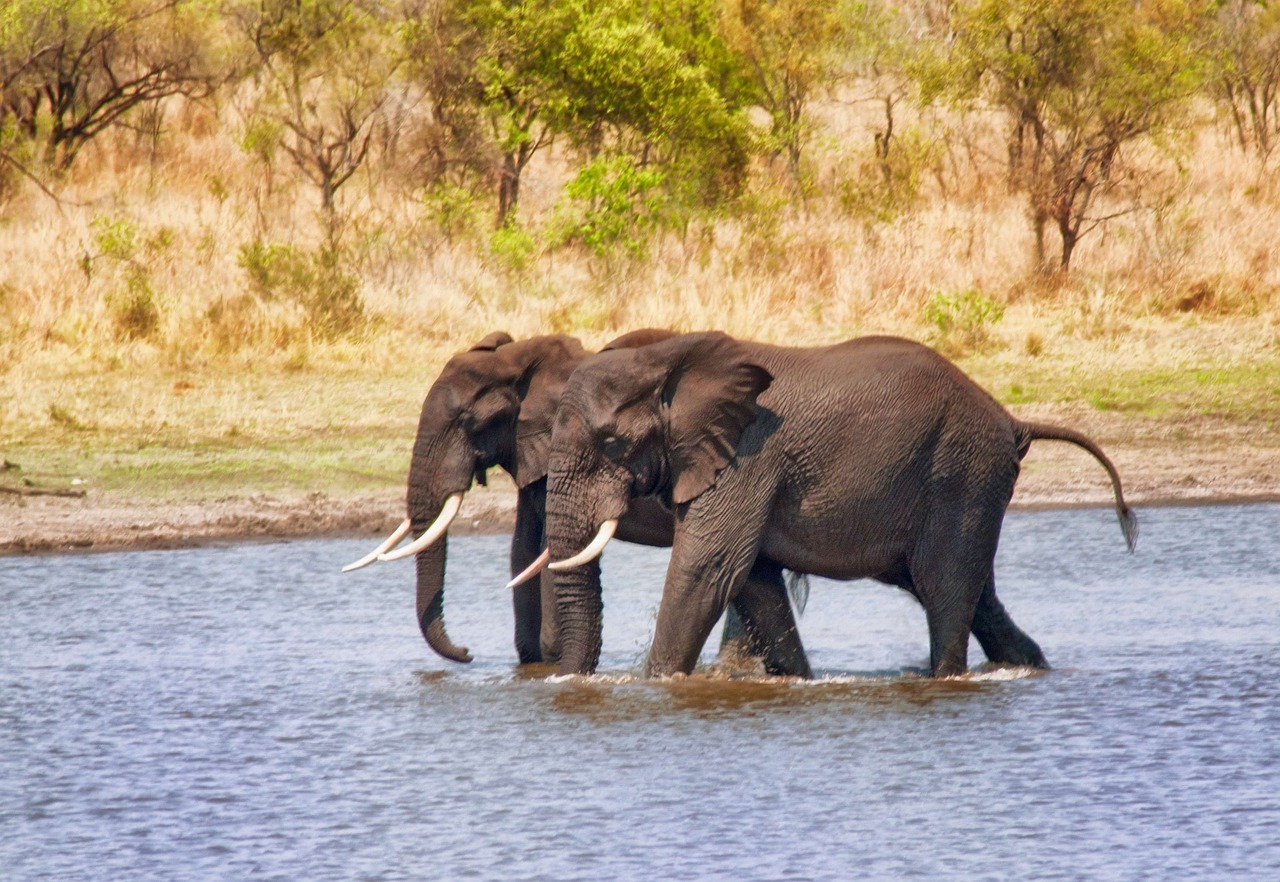The Role of AI in Future Environmental Conservation
As we stand on the brink of a new era in environmental conservation, the integration of artificial intelligence (AI) is poised to revolutionize how we approach the preservation of our planet's resources. Imagine a world where technology not only aids us in understanding our environment but actively contributes to its protection. This is not just a distant dream; it is becoming a reality. The potential of AI in conservation is vast, offering innovative solutions to some of the most pressing challenges we face today.
AI's ability to process and analyze large datasets enables us to gain insights into ecological patterns and trends that were previously unattainable. For instance, AI can help track wildlife movements, predict climate changes, and optimize resource management. The applications are numerous and varied, ranging from monitoring endangered species to predicting natural disasters. But what does this mean for the future of conservation?
First and foremost, AI can enhance our understanding of biodiversity. By utilizing advanced algorithms, researchers can identify species in real-time, monitor their habitats, and even analyze their behaviors. This data is crucial for developing targeted conservation strategies. For example, AI-driven drones can survey vast areas of land, collecting data on wildlife populations and their habitats while reducing the need for human presence in sensitive areas.
Moreover, AI plays a pivotal role in climate change mitigation. With its ability to analyze vast amounts of climate data, AI can identify patterns and trends that inform policymakers and conservationists alike. Imagine being able to predict the impacts of climate change on specific ecosystems years in advance. This foresight allows for proactive measures to be implemented, potentially saving countless species and habitats from destruction.
However, the integration of AI in environmental conservation is not without its challenges. As we embrace these technologies, we must also navigate the ethical considerations surrounding data privacy and the impact on local communities. Ensuring that AI solutions are equitable and inclusive is paramount for their success. Additionally, technological barriers, such as access to necessary infrastructure, can hinder the implementation of AI solutions in remote or underdeveloped regions.
In conclusion, the role of AI in future environmental conservation is not just about technology; it's about transforming our relationship with nature. By leveraging AI's capabilities, we can enhance our conservation efforts, making them more efficient and effective. As we look to the future, it is imperative that we embrace these innovations while remaining mindful of the ethical implications and challenges that accompany them. The journey toward a sustainable future is complex, but with AI as a partner, we can pave the way for a healthier planet.
- What is AI's role in wildlife conservation? AI helps in tracking endangered species, monitoring habitats, and combating poaching through advanced data analysis and real-time monitoring systems.
- How does AI contribute to climate change analysis? AI algorithms can analyze vast datasets to identify climate patterns, predict future scenarios, and assist policymakers in making informed decisions.
- Are there ethical concerns with using AI in conservation? Yes, ethical concerns include data privacy issues and the potential impact on local communities, which require careful consideration in conservation strategies.
- What challenges does AI face in conservation efforts? Challenges include technological barriers, limited access to infrastructure, and the need for interdisciplinary collaboration.
- What is the future potential of AI in environmental conservation? The future is promising, with advancements in AI expected to enhance our ability to protect the planet and promote sustainable practices.

AI Applications in Wildlife Conservation
Artificial intelligence is revolutionizing the field of wildlife conservation, introducing innovative solutions that were once deemed impossible. Imagine a world where conservationists can monitor endangered species in real-time, detect poachers before they strike, and analyze vast amounts of data to make informed decisions—all with the help of AI. This technology is not just a luxury; it’s becoming a necessity in our fight to protect the planet’s biodiversity.
One of the most significant applications of AI in wildlife conservation is through advanced monitoring systems. These systems utilize machine learning algorithms and computer vision to analyze images captured by camera traps in remote locations. For instance, researchers can quickly identify the species present in a particular area, track their movements, and even recognize individual animals based on unique patterns. This capability allows for a more comprehensive understanding of wildlife behavior and population dynamics.
Moreover, AI-powered drones are taking wildlife monitoring to new heights—literally! Equipped with high-resolution cameras and thermal imaging technology, these drones can cover vast areas in a fraction of the time it would take human researchers. They can detect changes in habitat, locate endangered species, and even monitor illegal activities such as poaching. In fact, studies have shown that using drones combined with AI can reduce poaching incidents by up to 80% in certain regions.
Another fascinating aspect of AI in wildlife conservation is its ability to predict poaching activities. By analyzing historical data, AI algorithms can identify patterns that precede poaching events. For example, they can consider factors such as weather conditions, seasonality, and even social media activity to forecast potential threats. This predictive capability allows conservationists to deploy resources more effectively, ensuring that they are in the right place at the right time to protect vulnerable species.
Furthermore, AI is enhancing community engagement in conservation efforts. Through mobile applications, local communities can report wildlife sightings or suspicious activities, contributing vital data to conservation organizations. This collaborative approach not only empowers local populations but also enriches the data pool that AI systems rely on, leading to more accurate insights and strategies.
While the benefits of AI in wildlife conservation are clear, it’s essential to acknowledge the need for ethical considerations. The deployment of AI technologies must be accompanied by respect for local communities and wildlife. Conservationists must ensure that the use of AI does not infringe on the rights of indigenous peoples or disrupt local ecosystems. Therefore, engaging communities in the development and implementation of AI solutions is crucial for fostering trust and ensuring sustainable practices.
In summary, the applications of AI in wildlife conservation are both transformative and promising. From advanced monitoring systems to predictive analytics and community engagement, AI is equipping conservationists with the tools they need to combat the numerous threats facing our planet’s wildlife. As we continue to innovate and integrate these technologies, the future of wildlife conservation looks brighter than ever.

Data Analysis for Climate Change
Artificial Intelligence (AI) is making waves in the realm of climate change by harnessing the power of data analysis. Imagine trying to solve a jigsaw puzzle with thousands of pieces scattered everywhere; that’s what understanding climate change feels like without the right tools. AI algorithms, however, act as the guiding hand, helping to piece together this complex puzzle. By analyzing vast amounts of climate data, these algorithms can identify patterns that human researchers might miss, thus enabling policymakers to make informed decisions that could steer our planet towards a sustainable future.
One of the most significant advantages of AI in climate data analysis is its ability to process information at lightning speed. Traditional methods of data analysis often take weeks or even months, while AI can churn through the same data in a matter of hours or days. This rapid processing capability allows scientists to keep up with the ever-changing climate landscape. For instance, AI can analyze satellite images to detect changes in forest cover, glacial retreat, or urban expansion, providing real-time insights that are crucial for timely interventions.
Moreover, AI's predictive capabilities are a game-changer. By using historical climate data, AI models can forecast future climate scenarios with remarkable accuracy. This is akin to having a weather forecast that not only tells you if it’s going to rain tomorrow but also predicts the likelihood of extreme weather events in the coming years. With this information, governments and organizations can prepare better, allocate resources more efficiently, and implement strategies that mitigate the impacts of climate change.
To illustrate the impact of AI in data analysis for climate change, consider the following table showcasing some of the key applications and their benefits:
| AI Application | Description | Benefit |
|---|---|---|
| Climate Modeling | Simulates climate scenarios based on various variables. | Helps in understanding potential future climates. |
| Data Mining | Extracts valuable insights from large datasets. | Identifies trends and anomalies in climate data. |
| Remote Sensing | Uses satellite imagery to monitor environmental changes. | Provides real-time data on deforestation, ice melt, etc. |
In the context of climate change, AI does not merely analyze data; it transforms it into actionable insights. For example, by correlating weather patterns with crop yields, AI can help farmers make better decisions about planting and harvesting, ultimately increasing food security in the face of climate variability. This synergy between AI and agriculture is just one of the many ways we can leverage technology to combat climate change.
However, it’s essential to recognize that while AI offers incredible potential, it also requires careful implementation. As we integrate AI into climate science, we must ensure that the data used is accurate, representative, and ethically sourced. This is crucial for building trust and ensuring that the insights generated benefit all communities, especially those most affected by climate change.
In conclusion, the role of AI in data analysis for climate change is not just about numbers; it's about creating a sustainable future. By leveraging advanced algorithms to interpret complex datasets, we can gain profound insights into our planet's health and make informed decisions that protect our environment for generations to come. The future is bright, but only if we harness this technology responsibly and inclusively.
- How does AI help in climate change research? AI analyzes large datasets quickly, identifies patterns, and predicts future climate scenarios, aiding researchers and policymakers.
- What are the main benefits of using AI in environmental conservation? AI enhances accuracy, speeds up data processing, and provides actionable insights for better decision-making.
- Are there any ethical concerns with AI in climate data analysis? Yes, issues like data privacy, representation, and the impact on local communities must be carefully considered.

Predictive Modeling Techniques
Predictive modeling techniques have emerged as a game-changer in the realm of environmental conservation. These techniques leverage the power of artificial intelligence to forecast environmental changes, enabling scientists and conservationists to take proactive measures before issues escalate. Imagine having a crystal ball that shows not just the weather for the next week but also the potential shifts in ecosystems over the next decade! This is precisely what predictive modeling aims to achieve.
At the heart of predictive modeling are complex algorithms that process vast amounts of data. This data can come from various sources, including satellite imagery, sensor networks, and historical climate records. By analyzing these datasets, AI can identify patterns that might be invisible to the naked eye. For example, researchers can predict how rising temperatures might affect the migration patterns of birds or how changes in precipitation could impact plant growth in a specific region.
One of the most exciting aspects of predictive modeling is its ability to simulate different scenarios. By inputting various variables—such as greenhouse gas emissions, land use changes, and conservation efforts—scientists can create models that project future outcomes. This allows policymakers to visualize the potential impacts of their decisions, making it easier to advocate for sustainable practices. For instance, if a model shows that certain conservation strategies could prevent a species from going extinct, it provides a compelling argument for funding those initiatives.
To illustrate the effectiveness of predictive modeling, consider the following table that outlines some key applications and their benefits:
| Application | Benefits |
|---|---|
| Wildlife Population Forecasting | Helps in planning conservation efforts by predicting population trends. |
| Habitat Change Prediction | Identifies areas at risk due to climate change, guiding conservation priorities. |
| Disaster Response Planning | Improves preparedness and response strategies for natural disasters. |
Moreover, predictive modeling can also aid in understanding the interactions between various environmental factors. For instance, how does deforestation affect local rainfall patterns, or what happens to biodiversity when a new species is introduced to an ecosystem? By answering these questions, scientists can develop more effective conservation strategies that take into account the interconnectedness of different ecological elements.
However, it’s important to note that while predictive modeling holds great promise, it is not without its challenges. The accuracy of predictions largely depends on the quality and quantity of data available. In regions where data is scarce or unreliable, predictions may not be as effective. Additionally, the complexity of ecological systems means that models can sometimes oversimplify reality, leading to unexpected outcomes. Therefore, continuous refinement and validation of these models are essential for ensuring their reliability.
In conclusion, predictive modeling techniques represent a powerful tool in the arsenal of environmental conservation. By harnessing the capabilities of AI, we can foresee potential environmental changes and take action to mitigate their effects. This proactive approach not only helps protect biodiversity but also fosters a more sustainable relationship between humans and the planet. As we continue to advance in technology and data collection, the future of predictive modeling in conservation looks incredibly promising.

Machine Learning in Climate Forecasting
When we talk about climate forecasting, we’re diving into the complex world of predicting weather patterns and understanding climate change. Enter machine learning, a powerful tool that’s shaking things up in this arena. Imagine trying to predict the weather without all the advanced technology we have today; it would be like trying to find your way in a dense fog without a flashlight! Machine learning algorithms are essentially our flashlights, illuminating the path to more accurate climate predictions.
These algorithms analyze vast amounts of data, from temperature readings to atmospheric pressure, and identify patterns that would be impossible for a human to detect. For instance, by examining historical climate data, machine learning models can recognize trends and anomalies, helping scientists forecast future conditions with remarkable precision. This capability is crucial, especially as we face the increasing unpredictability of weather patterns due to climate change.
One of the most exciting aspects of machine learning in climate forecasting is its ability to improve over time. The more data these systems process, the better they become at making predictions. Think of it like a student who learns from their mistakes; with each new piece of information, they refine their understanding and improve their performance. This continuous learning process allows for increasingly sophisticated models that can adapt to new variables, such as changes in human activity or natural events.
Moreover, machine learning can provide insights into climate variability — that is, the natural fluctuations in climate over time. Understanding these variations is essential for developing strategies to mitigate the effects of climate change. For example, if a machine learning model predicts a higher likelihood of drought in a specific region, policymakers can take proactive measures to conserve water and manage resources more effectively.
To illustrate the impact of machine learning, consider the following table that outlines the advantages of using machine learning in climate forecasting compared to traditional methods:
| Aspect | Traditional Methods | Machine Learning |
|---|---|---|
| Data Processing | Manual analysis; time-consuming | Automated analysis; rapid processing |
| Accuracy | Limited by human error | High accuracy through pattern recognition |
| Adaptability | Static models | Dynamic learning from new data |
| Predictive Capability | Short-term forecasts | Long-term climate trends |
As we move forward, the integration of machine learning into climate forecasting not only enhances our understanding of the environment but also empowers us to make informed decisions. By leveraging these advanced technologies, we can better prepare for the challenges that lie ahead, ensuring a sustainable future for our planet. So, the next time you hear about a climate prediction, remember that behind those numbers are sophisticated algorithms tirelessly working to keep us informed!
- What is machine learning? Machine learning is a subset of artificial intelligence that enables systems to learn from data patterns and improve their performance over time without being explicitly programmed.
- How does machine learning improve climate forecasting? By analyzing large datasets, machine learning algorithms can identify complex patterns and trends that enhance the accuracy of climate predictions.
- What are some challenges of using machine learning in climate science? Challenges include the need for large datasets, potential biases in data, and the requirement for interdisciplinary collaboration.
- Can machine learning predict extreme weather events? Yes, machine learning can help forecast extreme weather events by analyzing historical data and recognizing patterns associated with such occurrences.

Big Data and Environmental Insights
In today’s digital age, the sheer volume of data generated is nothing short of staggering. When we talk about big data, we’re referring to the massive amounts of information collected from various sources, including satellite imagery, sensor networks, and social media. This data holds the key to unlocking crucial insights into our environment. By harnessing the power of artificial intelligence (AI), we can sift through this vast ocean of information to identify trends, patterns, and anomalies that would otherwise go unnoticed.
Imagine trying to find a needle in a haystack. Now, picture that haystack as a mountain of data—this is where AI comes into play. It acts as a sophisticated tool that not only helps us locate that needle but also understand its significance in the bigger picture of environmental conservation. For instance, AI algorithms can analyze data from various environmental sensors to detect changes in air quality, water levels, and wildlife populations in real time.
One of the most exciting applications of big data in environmental insights is the ability to create detailed models that predict the impact of various factors on ecosystems. By integrating data from different sources, we can develop a comprehensive understanding of how climate change, pollution, and human activity affect biodiversity. This predictive capability is invaluable for conservationists and policymakers alike, allowing them to make informed decisions that can mitigate negative impacts before they escalate.
Furthermore, big data analytics can enhance our understanding of species distribution and habitat use. For example, researchers can analyze GPS tracking data from endangered species to determine their movement patterns and habitat preferences. This information can then be used to create targeted conservation strategies that focus on protecting critical habitats and migration corridors.
To illustrate the transformative power of big data in environmental conservation, consider the following table that summarizes some key insights generated through AI-driven data analysis:
| Data Source | Insight Generated | Application |
|---|---|---|
| Satellite Imagery | Deforestation rates | Targeted reforestation efforts |
| Wildlife Tracking | Migration patterns of endangered species | Protected area designations |
| Air Quality Sensors | Pollution hotspots | Policy changes for industrial regulation |
As we continue to develop and refine these technologies, the potential for big data to inform environmental conservation efforts becomes increasingly apparent. However, it’s crucial to remember that the effectiveness of big data analytics relies not just on the algorithms themselves but also on the quality of the data being collected. This necessitates a commitment to gathering accurate and comprehensive data, as well as ensuring that it is accessible to those who need it most.
In conclusion, the intersection of big data and AI is paving the way for a new era in environmental conservation. By leveraging these technologies, we can gain insights that empower us to act more effectively in protecting our planet's precious resources. The future of conservation is not just about protecting what we have; it's about understanding the intricate web of life that sustains us and using that knowledge to ensure a sustainable future for generations to come.
- What is big data? Big data refers to extremely large datasets that can be analyzed computationally to reveal patterns, trends, and associations, especially relating to human behavior and interactions.
- How does AI contribute to environmental conservation? AI helps analyze vast amounts of environmental data, enabling more accurate predictions and informed decision-making in conservation efforts.
- What are some challenges of using big data in conservation? Challenges include data privacy concerns, the need for high-quality data, and ensuring equitable access to technology.

AI in Renewable Energy Management
In an era where the urgency for sustainable energy solutions has never been more critical, artificial intelligence (AI) is stepping into the limelight as a game-changer in renewable energy management. Imagine a world where energy consumption is optimized to the point that we not only reduce waste but also maximize the potential of renewable resources like solar, wind, and hydro. AI is not just a buzzword; it is the backbone of innovative technologies that are transforming how we produce, distribute, and consume energy.
One of the most remarkable applications of AI in this field is its ability to analyze real-time data from various sources. For instance, AI algorithms can predict energy demand by analyzing patterns in consumption data, weather forecasts, and even social events. This predictive capability enables energy providers to adjust their output proactively, ensuring that supply meets demand without over-relying on fossil fuels. By using AI to manage energy loads, we can significantly reduce greenhouse gas emissions and enhance the efficiency of renewable energy systems.
Moreover, AI plays a crucial role in optimizing the performance of renewable energy sources. For example, in solar energy management, AI systems can analyze data from solar panels to detect inefficiencies or malfunctions. This not only helps in maintaining the health of the solar installations but also ensures that they operate at peak efficiency. Similarly, in wind energy, AI can predict wind patterns and optimize turbine operations, thereby increasing energy production while minimizing downtime.
To illustrate the impact of AI on renewable energy management, consider the following table that summarizes key benefits:
| Aspect | Benefits |
|---|---|
| Energy Production | Increased efficiency and output from renewable sources. |
| Demand Forecasting | Accurate predictions reduce waste and enhance grid stability. |
| Maintenance | Proactive maintenance reduces downtime and operational costs. |
| Integration | Smoother integration of renewable energy into existing grids. |
However, the integration of AI in renewable energy management is not without its challenges. Data privacy issues and the need for robust cybersecurity measures are paramount, especially as energy grids become more interconnected and reliant on digital solutions. Furthermore, the initial investment in AI technologies can be substantial, which may deter smaller companies from adopting these innovations. Nevertheless, the long-term benefits far outweigh these hurdles, paving the way for a more sustainable future.
In conclusion, the potential of AI in renewable energy management is vast and largely untapped. As technology continues to advance, we can expect even more innovative solutions that will not only enhance energy efficiency but also contribute significantly to the fight against climate change. By embracing AI, we can create a cleaner, greener planet for future generations.
- How does AI improve energy efficiency? AI enhances energy efficiency by analyzing consumption patterns and optimizing energy production to meet demand without waste.
- What are the challenges of implementing AI in renewable energy? Challenges include data privacy concerns, high initial costs, and the need for robust cybersecurity measures.
- Can AI predict energy demand accurately? Yes, AI algorithms can analyze historical data and current trends to make accurate predictions about energy demand.
- Is AI essential for the future of renewable energy? While not essential, AI significantly enhances the effectiveness and efficiency of renewable energy systems, making it a valuable tool for the future.

Challenges of Implementing AI in Conservation
As promising as artificial intelligence (AI) is for revolutionizing environmental conservation, it doesn't come without its share of challenges. One of the most pressing concerns is data privacy. With the rise of AI, vast amounts of data are collected, often including sensitive information about local communities and wildlife habitats. This raises the question: how do we balance the need for data with the rights of individuals? It's crucial that conservationists approach data collection with transparency and respect for privacy, ensuring that local communities are informed and involved in the process.
Another significant challenge lies in technological barriers. In many regions, especially in developing countries, access to the necessary technology and infrastructure is limited. Without reliable internet connections or the latest hardware, implementing AI solutions can be next to impossible. This disparity creates a gap between regions that can leverage AI for conservation and those that cannot, leading to unequal conservation efforts across the globe. To address this, initiatives must focus on equitable resource distribution, providing the necessary tools and training to those in need.
The need for interdisciplinary collaboration cannot be overstated. AI in conservation is not just about technology; it requires the expertise of ecologists, data scientists, and local stakeholders working together. However, fostering this collaboration can be challenging due to differing priorities and communication barriers. For instance, while data scientists may prioritize algorithm efficiency, ecologists might focus on ecological integrity. Bridging this gap requires open dialogue and a shared vision for conservation goals.
Moreover, there are ethical considerations that must be taken into account. The use of AI can inadvertently lead to the marginalization of local communities, especially if their voices are not included in the decision-making process. It's essential to adopt inclusive approaches that empower these communities, ensuring they have a say in how AI is utilized in their environments. This not only fosters trust but also enhances the effectiveness of conservation strategies.
In summary, while AI presents exciting opportunities for environmental conservation, it also poses significant challenges that must be addressed. By focusing on data privacy, technological access, interdisciplinary collaboration, and ethical considerations, we can pave the way for a more effective and inclusive approach to conservation efforts. The road ahead may be fraught with obstacles, but with collective effort and innovative thinking, we can harness the power of AI to protect our planet.
- What are the main challenges of using AI in conservation?
The main challenges include data privacy concerns, technological barriers, the need for interdisciplinary collaboration, and ethical considerations regarding local community involvement. - How can data privacy be ensured in AI conservation efforts?
Data privacy can be ensured by implementing transparent data collection practices and involving local communities in the decision-making process. - Why is interdisciplinary collaboration important in AI conservation?
Interdisciplinary collaboration ensures that diverse perspectives are considered, leading to more effective and holistic conservation strategies. - What role do local communities play in AI conservation?
Local communities are vital in providing insights and knowledge about their environments, and their involvement helps ensure that conservation efforts are respectful and effective.

Ethical Considerations
As we delve into the intersection of artificial intelligence and environmental conservation, it’s crucial to address the ethical considerations that accompany this technological revolution. While AI has the potential to revolutionize how we approach conservation, it also raises significant questions about data privacy, community impact, and equity in resource allocation. For instance, when AI systems collect data on endangered species, who owns that data? Is it the researchers, the organizations funding the projects, or the communities where the data is gathered? These questions are not just academic; they have real-world implications for the communities involved.
Moreover, the deployment of AI technologies often necessitates the involvement of local communities, who may have their own perspectives and traditional knowledge regarding conservation efforts. Ignoring these voices can lead to a disconnect between conservation strategies and the people who live in and depend on these ecosystems. It’s essential to foster a collaborative approach that includes local insights, ensuring that conservation efforts are not only scientifically sound but also socially responsible.
Additionally, as AI systems become more prevalent in conservation, we must consider the potential for bias in algorithms. If the data used to train these systems is skewed or unrepresentative, the outcomes can perpetuate inequalities or overlook critical conservation needs. For example, if a machine learning model is trained predominantly on data from one geographic area, it may fail to accurately predict patterns in another region, leading to ineffective conservation measures. Hence, a thorough evaluation of data sources and algorithmic fairness is vital.
To address these ethical dilemmas, we need to establish guidelines and frameworks that prioritize transparency, accountability, and inclusivity in AI applications for conservation. This could involve:
- Engaging local communities in the design and implementation of AI projects.
- Ensuring that data collection methods respect the privacy and rights of individuals.
- Regularly auditing AI systems for bias and performance across different contexts.
Ultimately, the goal is to harness the power of AI in a way that not only enhances our conservation efforts but also respects the rights and needs of all stakeholders involved. By navigating these ethical considerations thoughtfully, we can ensure that the integration of AI into environmental conservation is both effective and equitable.
Q: What are the main ethical concerns regarding AI in environmental conservation?
A: The primary ethical concerns include data privacy, the impact on local communities, and potential biases in AI algorithms that can affect conservation outcomes.
Q: How can local communities be involved in AI-driven conservation efforts?
A: Local communities can be engaged through participatory approaches that include their traditional knowledge and insights in the design and implementation of AI projects.
Q: Why is transparency important in AI applications for conservation?
A: Transparency ensures accountability and helps build trust among stakeholders, allowing for better collaboration and more effective conservation strategies.

Technological Barriers
When we talk about the integration of artificial intelligence in environmental conservation, it's easy to get swept away by the excitement of technological advancements. However, the reality is that there are significant that can impede progress. One of the most pressing issues is the limited access to technology in many parts of the world. While urban areas may be buzzing with innovation and AI applications, rural regions often lag behind due to a lack of infrastructure. Imagine trying to implement a cutting-edge AI monitoring system in a remote rainforest; without reliable internet and electricity, those efforts could quickly fall flat.
Moreover, the disparity in technological resources creates a gap between regions that can afford to invest in AI and those that cannot. This inequity not only hampers local conservation efforts but also raises questions about the global collaboration needed to tackle environmental issues effectively. If only a select few regions have access to the latest AI tools, how can we expect to address problems like poaching or deforestation on a global scale? This is where the concept of equitable resource distribution becomes crucial.
Another challenge is the complexity of AI systems. Many conservation organizations may not have the technical expertise required to implement and maintain these systems. For instance, a small nonprofit dedicated to protecting endangered species might struggle to hire data scientists or AI specialists, leaving them at a disadvantage compared to larger organizations with more resources. Training local staff and building capacity in these communities is essential, yet it requires time, investment, and commitment.
To better illustrate these challenges, consider the following table that outlines the key technological barriers faced in implementing AI for environmental conservation:
| Barrier | Description |
|---|---|
| Limited Access to Technology | Many regions lack the necessary infrastructure, such as reliable internet and electricity, to support advanced AI systems. |
| Resource Disparity | Wealthier regions can invest in AI tools, leaving poorer areas without the means to adopt similar technologies. |
| Complexity of AI Systems | Smaller organizations may not have the technical expertise to implement and maintain AI solutions. |
In summary, while the potential of AI in environmental conservation is enormous, we must address these to ensure that all regions can benefit from these innovations. By fostering collaborations, investing in infrastructure, and providing training, we can create a more equitable landscape for conservation efforts worldwide.
- What are the main technological barriers to implementing AI in environmental conservation?
Limited access to technology, resource disparity, and the complexity of AI systems are significant barriers. - How can we overcome these technological challenges?
Investing in infrastructure, fostering collaborations, and providing training to local communities can help bridge the gap. - Why is equitable resource distribution important in conservation?
It ensures that all regions, especially those in need, can access advanced technologies to tackle environmental issues effectively.

The Future of AI in Environmental Conservation
The future of artificial intelligence (AI) in environmental conservation is not just a fleeting trend; it represents a transformative shift in how we approach the preservation of our planet. Imagine a world where technology and nature coexist harmoniously, where AI algorithms work tirelessly to protect endangered species and restore ecosystems. This vision is becoming increasingly possible as advancements in AI continue to unfold.
One of the most exciting prospects lies in the development of smart ecosystems. These are environments equipped with sensors and AI-driven systems that monitor ecological health in real-time. For instance, consider a forest where drones equipped with AI analyze tree growth, detect diseases, and even identify illegal logging activities. This proactive approach allows for immediate action, ensuring that conservation efforts are timely and effective.
Moreover, the integration of AI with the Internet of Things (IoT) could lead to unprecedented levels of data collection and analysis. Imagine a network of sensors spread across various ecosystems, collecting data on everything from soil moisture levels to animal migration patterns. AI can sift through this massive amount of data, identifying trends and providing insights that were previously impossible to acquire. This level of understanding will enable conservationists to make data-driven decisions that are crucial for effective resource management.
Furthermore, as AI technology evolves, we can expect to see advancements in collaborative conservation efforts. By leveraging AI, organizations and communities can work together more efficiently. For instance, AI platforms could facilitate information sharing among conservation groups, allowing them to pool resources and knowledge. This collaborative approach not only enhances the effectiveness of conservation strategies but also fosters a sense of community and shared responsibility for the environment.
However, with great potential comes great responsibility. As we embrace AI in conservation, we must also address the ethical implications of its usage. It’s essential to ensure that AI technologies are developed and deployed in ways that are inclusive and equitable. This means involving local communities in the decision-making process and ensuring that their voices are heard. By doing so, we can create conservation strategies that are not only effective but also socially responsible.
In conclusion, the future of AI in environmental conservation is bright and full of promise. As we harness the power of AI, we open new avenues for protecting our planet's precious resources. The combination of smart ecosystems, collaborative efforts, and ethical considerations will pave the way for a sustainable future. With AI, we are not just imagining a better world; we are actively working towards it.
- How is AI currently being used in environmental conservation? AI is used for wildlife monitoring, data analysis for climate change, and optimizing renewable energy management.
- What are the ethical considerations of using AI in conservation? Ethical considerations include data privacy, the impact on local communities, and ensuring inclusive approaches to conservation strategies.
- What challenges does AI face in conservation efforts? Challenges include technological barriers, limited access to resources, and the need for interdisciplinary collaboration.
- What is the potential future impact of AI on environmental practices? AI has the potential to enhance our ability to protect ecosystems, improve resource management, and foster collaborative conservation efforts.
Frequently Asked Questions
- How is AI used in wildlife conservation?
AI is revolutionizing wildlife conservation by providing advanced monitoring systems that allow researchers to track endangered species and combat poaching more effectively. For example, AI-powered cameras can detect and identify animals in real-time, alerting conservationists to potential threats.
- What role does AI play in analyzing climate data?
AI algorithms can sift through massive amounts of climate data to identify patterns and predict future climate scenarios. This capability helps policymakers make informed decisions, ensuring that strategies to combat climate change are based on accurate and timely information.
- Can AI help in renewable energy management?
Absolutely! AI technologies optimize both the production and consumption of renewable energy. By analyzing energy usage patterns, AI can help balance supply and demand, leading to more efficient energy systems that reduce our reliance on fossil fuels.
- What challenges does AI face in conservation efforts?
While AI has immense potential, it also faces several challenges. These include data privacy concerns, technological barriers in less developed regions, and the need for interdisciplinary collaboration to effectively implement AI solutions in conservation.
- Are there ethical concerns related to AI in environmental conservation?
Yes, the use of AI raises important ethical questions, particularly regarding data usage and its impact on local communities. It’s crucial to adopt inclusive approaches in conservation strategies to ensure that all stakeholders are considered.
- What does the future hold for AI in environmental conservation?
The future of AI in environmental conservation is promising. As technology continues to advance, AI is expected to enhance our ability to protect the planet and promote sustainable practices, making it an essential tool in our fight against environmental degradation.


















